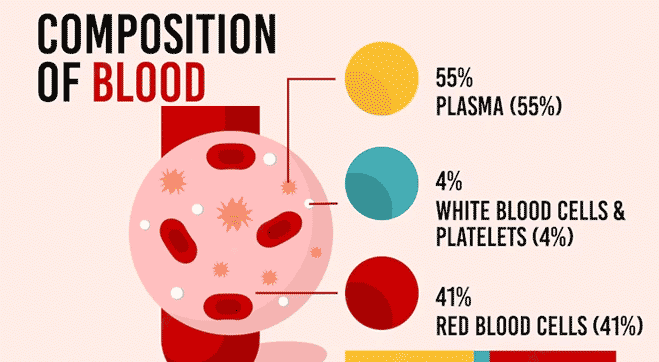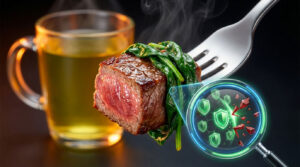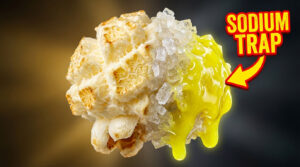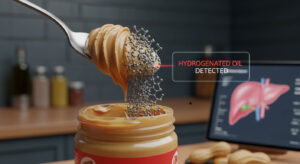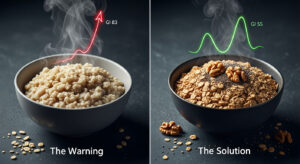Blood is a tissue that contains red blood cells, white blood cells, platelets, and other substances suspended in fluid called plasma. Blood that travels through the veins, arteries and capillaries is called as whole blood. 55 composed of plasma and about 45% is contributed by different types of blood cells. Blood is an essential fluid that possesses important functions.
Transportation Blood carries oxygen from the lungs to the cells of the body for metabolism. The carbon dioxide produced during metabolism is carried back to the lungs from where it is exhaled out. Blood also nourishes the cells with nutrients, transports hormones and removes waste products with the help of liver, Kidneys and intestines.
Regulation Blood helps in regulating body temperature. This is done in two ways, first, blood plasma can absorb or give off heat as required, and the other way is due to the speed at which blood flows in the blood vessels. Heat is lost when the blood vessels expand and speed of the blood flow reduces. When the environmental temperature is low the blood vessels contract so that very little heat is lost. The pH value of the blood is also maintained at the ideal level for the body. The pH indicates how acidic or alkaline a liquid is. Maintaining a near-constant pH value is very important for bodily functions.
Protection Certain components of blood clot together to protect against losing blood when blood vessels get damaged. This is important to ensure that wounds do not cause an individual to bleed to death. White blood cells and, other components of the immune system play a major role in protection of the body against pathogenic attacks.
Blood consists of various types of cells with unique functions, ranging from oxygen transport to antibody production Continuous process of replenishing the cellular constituents of blood that is, blood cell formation, is known as hematopoiesis. Formation of these cellular components occurs during the development of embryo and continues throughout life to produce and replenish the blood cells.
In humans, the process of blood cell formation begins in the yolk sac and transitions first into the liver temporarily before finally establishing in the bone marrow and thymus. Some of the cells function completely in the vascular system while the other cells use this vascular system as a mode of transportation and implement their functions in other system. However, all the blood cells possess certain similarities such as originating from a common stem cell in the bone marrow, having limited life span and are produced throughout the life. These blood forming stem cells are therefore, multipotent, as they gives rise to all types of terminally differentiated blood cells. These stem cells are found, circulating in blood and bone marrow as well as in the umbilical cords of newborn babies. These have the ability to treat various immune disorders.
Components of Blood
The components of human blood are
‘ Plasma
The clear yellowish fluid that is obtained after centrifugation of anti Plasma coagulated blood is
called plasma which is a mixture of water, sugar, fat, protein, salts and many other dissolved and
suspended substances. RBCS, WBCs and platelets are suspended in plasma. Plasma plays a major
role in transporting blood cells throughout the body along with other substances such as nutrients,
waste products, antibodies and clotting proteins. Proteins responsible to form blood clots are in
plasma. Plasma also transports chemical messengers such as hormones, and proteins that help
maintain the body’s fluid balance.
‘ Blood cells
Blood cells can be classified as red blood cells and white blood cells. Red blood cells, also
known as erythrocytes, remain within the blood vessels and function to transport and CO, bound
to hemoglobin. White blood cells also known as leukocytes battle infections and digest debris.
Leukocytes have the ability to make their path across the walls of blood vessels and itinerate in
tissues to perform their tasks. Blood also contains platelets that are small, detached cell fragments,
or minicells derived from megakaryocytes.
Red Blood Cells (RBCs or Erythrocytes)
RBCs are the most common type of cell found in blood which are produced in the bone marrow
and released into circulation. Their production is controlled by erythropoietin, a hormone produced
in the kidney. This type not have a nucleus, at a concentration of 4-6 million cells per cubic millimeter
of blood. With a diameter of 7-8 pm, these cells are minute enough to be flexible and pass through
the smallest blood vessels. RBCs are also biconcave in shape which benefits them in increasing their
surface area for the diffusion of oxygen across their surfaces.
RBCs circulates for 120 days in the body and the damaged or old cells are removed from the circulation in the liver and spleen with the help of macrophages. Red blood cells possesses hemoglobin, the oxygen-binding protein that enables the RBC to transport more oxygen. Hemoglobin is also the pigment that gives the RBCs their red color. The ratio of the volume of the red blood cell to the whole blood volume is known as hematocrit and is a measure of red blood cells.
White Blood Cells (WBCs or Leukocytes)
WBCs are a part of the body’s immune response. These cells are fewer in number comparative to
RBCs. Some of these WBCs possess nuclei with multiple lobes, while the others contain round nucleus.
Some WBCs also contain packets of granules in their cytoplasm, hence are called granulocytes.
Primary role of WBCs is to defend the body against infection. Every type of WBCs have their specific
roles in immune response. Until a signal is received that a part of the body is damaged or infected,
these WBCs circulate in the blood. Once these signals are received, WBCs take action by migrating
through the blood vessel to the site of the signal and initiate the resolution of infection.
There are five main types of WBCS
- Neutrophils
The most numerous type and also known as polymorphonuclear cells as they contain irregularly shaped nucleus with 2-4 lobes. These cells have their cytoplasm containing granules therefore belong to a group called granulocytes. The granules present in the neutrophils contain enzymes and other compounds that favor them in killing and digesting the pathogens. This type is known for its immediate reaction against a pathogen, and their life span is less than a day. Therefore, it is obligatory for the bone marrow to constantly produce new neutrophils to maintain protection against infection. - Lymphocytes
One of the major type of WBCs that are round cells having a single large round nucleus. About 2 x 10″ lymphocytes are present in the human body. They are developed in the thymus and bone marrow, and the newly formed lymphocytes migrate from these primary organs to peripheral lymphoid organs where they come in contact with the foreign antigens. There are two main classes of lymphocytes
1) B cells -mature in the bone marrow.
2) T cells-mature in the thymus gland.
On activation, both the B cells and T cells initiates different types of immune response. B lymphocytes produce antibodies, that are protein specifically targeting foreign materials such as virus, bacteria, etc Specific antibodies of activated plasma cells (a type of B cells), also directly bind to the agent that initiated the immune response. T cells regulate the functions of immune system and either directly attack various infected cells and tumors, or activate other cells to do so. T cells called the helper T cells secrete chemicals that recruit other immune cells and help coordinate their attack. Cytotoxic T cells are another group that corners viral infected cells and cancer cells. Apart from T cells, Natural killer cells (NK) are effector lymphocytes that protect against viral infections and can detect and destroy some cancer cells. - Monocytes
It is said to be the youngest WBCs that circulates in the blood. These cells when they leave the blood and migrate into the tissues, and develop into macrophages. In tissues, they contribute to immediate defense as they can engulf and digest pathogens before other types of WBCS could reach the affected area. Macrophages functions to discard harmful agents in different organs. Tissue macrophages in the liver are also called as Kupffer cells. These cells specialize in discarding harmful agents from blood entering the liver. Alveolar macrophages present in the lungs help discard harmful agents that may have been inhaled and have reached lung tissues. Macrophages present in the spleen discard old or damaged RBCs or platelets from circulation. These cells are also included among a type of immune cells called “antigen presenting cells” as they process and present the foreign particles (antigen) to other immune cells, thus initiating an immune response. - Eosinophils
A type of granulocyte, eosinophils are considered end stage cells involved in protection against parasites. This immune cell consists of granules with enzymes, and are released during parasitic and fungal infections, asthma, as well as allergic reactions. It is also involved in destroying cancer cells. - Basophils
Basophils are the least abundant population of granulocyte in the blood consisting less than one percent of leukocytes. They develop from common hematopoietic stem cells (HCS)- derived granulocyte-monocyte progenitor cells (GMPs) that are present in the bone marrow. These basophils are highly active in the inflammatory response. In addition to fighting parasitic infections, they play a major role in preventing blood clotting as they contain heparin (naturally occurring anticoagulant). These cells also mediate allergic reaction by releasing histamine when the immune system is exposed to an allergen. This initiates an allergic reaction and inflammatory responses underlying this condition are associated with the production of antibody called immunoglobulin E (IgE). - Platelets
Platelets also known as thrombocytes are actually not cells and are described as irregularly shaped fragments of megakaryocytes. They circulate in the blood until they are activated to form a blood clot and removed by the spleen. Platelets plays a major role in coagulation process which is the blood clotting process that occurs by accumulation of these cells at the site of injury to form a platform for blood coagulation to form. This results in the production of fibrin clot that prevents the wound from bleeding. Low levels of platelets resulting in increased risk of bleeding, a condition known as thrombocytopenia, conversely, higher levels of platelets results in increased risk of forming blood clots that may lead to a chance to deprive essential organs such as heart and brain of their blood supply by clogging essential blood vessels that supply blood to these organs.
Blood though seems to be just a fluid, manifests significant contribution to us throughout our life.

